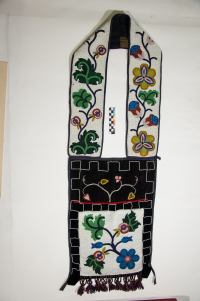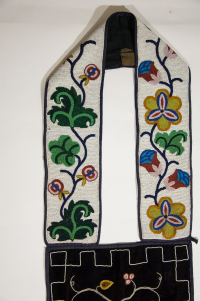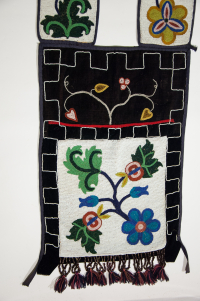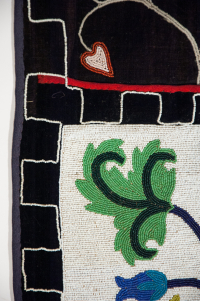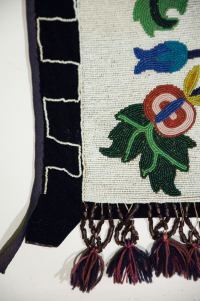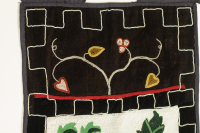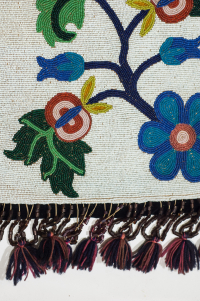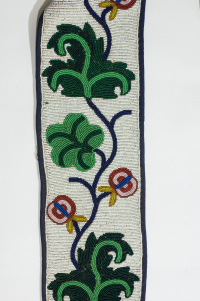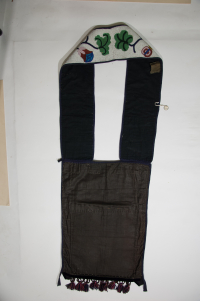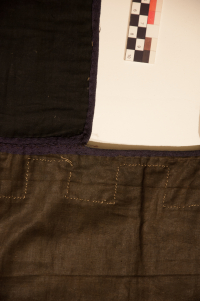Bandolier Bag
Bandolier Bag
Bandolier Bag
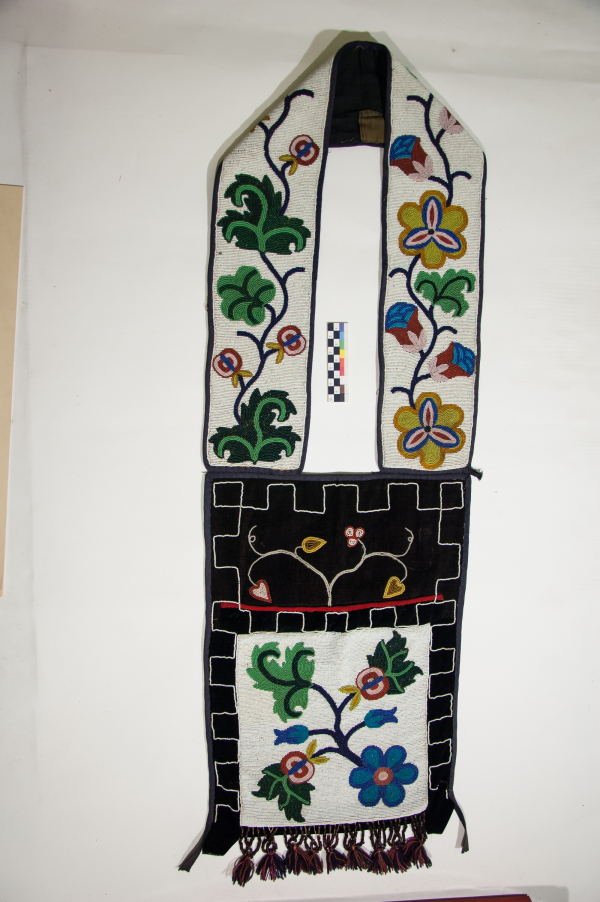
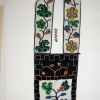
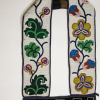
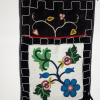
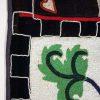
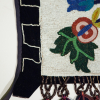
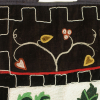
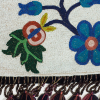

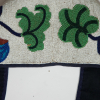

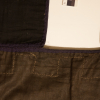
Overlaid spot stitch appliqué beadwork of curvilinear floral, stem & leaf beadwork on white field, faceted tube beads with yarn fringe, non-functional pocket
Attributed to the Saulteaux cultural type.
Summary of available descriptive information
Read More About This Relative
Fabric, cotton, charcoal & blue; Fabric, velveteen, black; Notions, bias tape, red (medium)& blue (blueberry); Yarn, blue (navy) & pink (flamingo); Tubular beads, brown (transparent, dark); Seed beads, metal, faceted, silver-coloured; Seed beads, white (opaque white, opaque pearl), red (opaque medium red, transparent medium red, opaque rose, transparent rose), yellow (opaque greeny-yellow, transparent medium yellow), green (opaque medium green, transparent dark green, transparent pine), blue (three opaque shades from medium blue-navy).
Hand sewn pouch panel (non-functional pouch) and straps; Straps lined with blue cotton; Pouch panel and pouch made of charcoal colour cotton that forms bottom corner tabs; Pouch panel and straps edged with blue bias tape ending in bottom corner tabs; Top edge of pouch edged in red bias tape; Decorative panel above pouch area in black velveteen; Fringe is nine sets of four strands of brown faceted tube beads tied with pink and blue yarn.
Velveteen encompassing pouch decorated white seed beads in block outline design; Straps and pouch panel decorated in overlaid spot stitch appliqué beadwork of multi-coloured curvilinear stems, six petalled floral, fruit and leaf beadwork designs on white field; Pouch panel symmetrical in design, straps asymmetrical.
Bandolier bags most likely originated in the Upper Great Lakes region during the 1840s and 1850s. Fashioned exclusively from European materials and adorned with thousands of beads, bandolier bags were primarily for show, as a symbol of identity, wealth and status. Although initially functional, by the late 19th and early 20th centuries many of the bags had false pockets or none at all. Sometimes called "friendship bags", they were often created as gifts to strengthen relationships within communities or between nations. By the 1870s they had become an important element of formal dress worn mainly at ceremonies and celebrations by men, and occasionally by women. They wore them - singly or several at a time - crossed over the torso or draped around the neck. “The wearing of more than one bag was generally the prerogative of a leader or a person of high honour." (McCord, 2013) “Bandoliers were adopted by Ojibwa in 19th century after seeing bullet pouches used by British soldiers. Bullet pouches were plain and decorated with crest or coat of arms. When idea adopted by Ojibwa, they were greatly prized and highly decorated ceremonial accessories. They became so highly prized by Ojibwa and other tribes (especially Sioux), that one bandolier could be traded for one pony. They became a status symbol of highest ranking Midewiwin priests.(Flanders, 1977)
The method of manufacture and locality suggests an associated with H4-11-7.
Provenance
McCord Museum, Wearing Our Identity. Montreal: The McCord Museum, 2013; and “Beads: Their Use By Upper Great Lakes Indians” by Richard Flanders, 1977
McCord Museum. Wearing Our Identity. Montreal: The McCord Museum, 2013. Print.
About This GRASAC Record
Manitoba Museum
Content from the Manitoba Museum's catalog records. Uploaded by Orvis Starkweather as part of their summer internship.













Attributed to Northeast Great Lakes-Riverine Geo-cultural area.
 Knowledge Sharing Platform
Knowledge Sharing Platform

